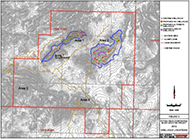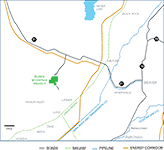The Blawn Mountain project is predominantly comprised of low and rounded to moderately steep hills that run in a north-south direction and generally have a maximum elevation of 8,000 or 9,000 feet above sea level. The nearest towns are Milford, Utah (pop. 1,500), about 31 miles northeast and Cedar City, Utah (pop. 21,000) about 56 miles southeast.
As delineated on the map below, the Blawn Mountain Project is comprised of four areas of alunite mineralization covering approximately 11,550 acres of state-owned land. The four areas where historic drilling occurred are licensed to Potash Ridge. They are referred to as Areas 1-4 as shown in the map below.
 |
 |
| click to enlarge |
click to enlarge |
The project consists of 18.5 sections of state land owned by SITLA (State of Utah School and Institutional Trust Lands Administration). State-owned land provides Potash Ridge with several advantages including a simpler permitting process, leasehold and royalty agreements in place and no environmental, social or aboriginal issues. Most importantly, the Blawn Mountain project has the support of both the municipality and state.
The necessary infrastructure for the construction and operation of the Blawn Mountain Project is nearby. The Project is located about 20 miles west of Union Pacific Railraod route, 12 miles south of Highway 21, and 62 miles west of Interstate 15, the main north-south travel corridor through Utah. State highways SR-21 and SR-130 pass approximately 30 miles east of the Project. Two energy corridors pass to the east of the Blawn Mountain Project.
The area surrounding the Project supports businesses that can supply construction materials such as sand, gravel, limestone, railroad ballast and cement. Heavy equipment, industrial supplies, mining support services and an experienced labour force are also available in Utah and neighbouring states to support construction, mining and processing operations.
Potash Ridge proposes to extract alunite from the project through surface mining operations, which are lower-cost and lower-risk than underground mining operations.